Y-12 Blog
May is the month to celebrate the mothers in our lives. Some lucky employees even have the privilege of working with their mothers on-site.
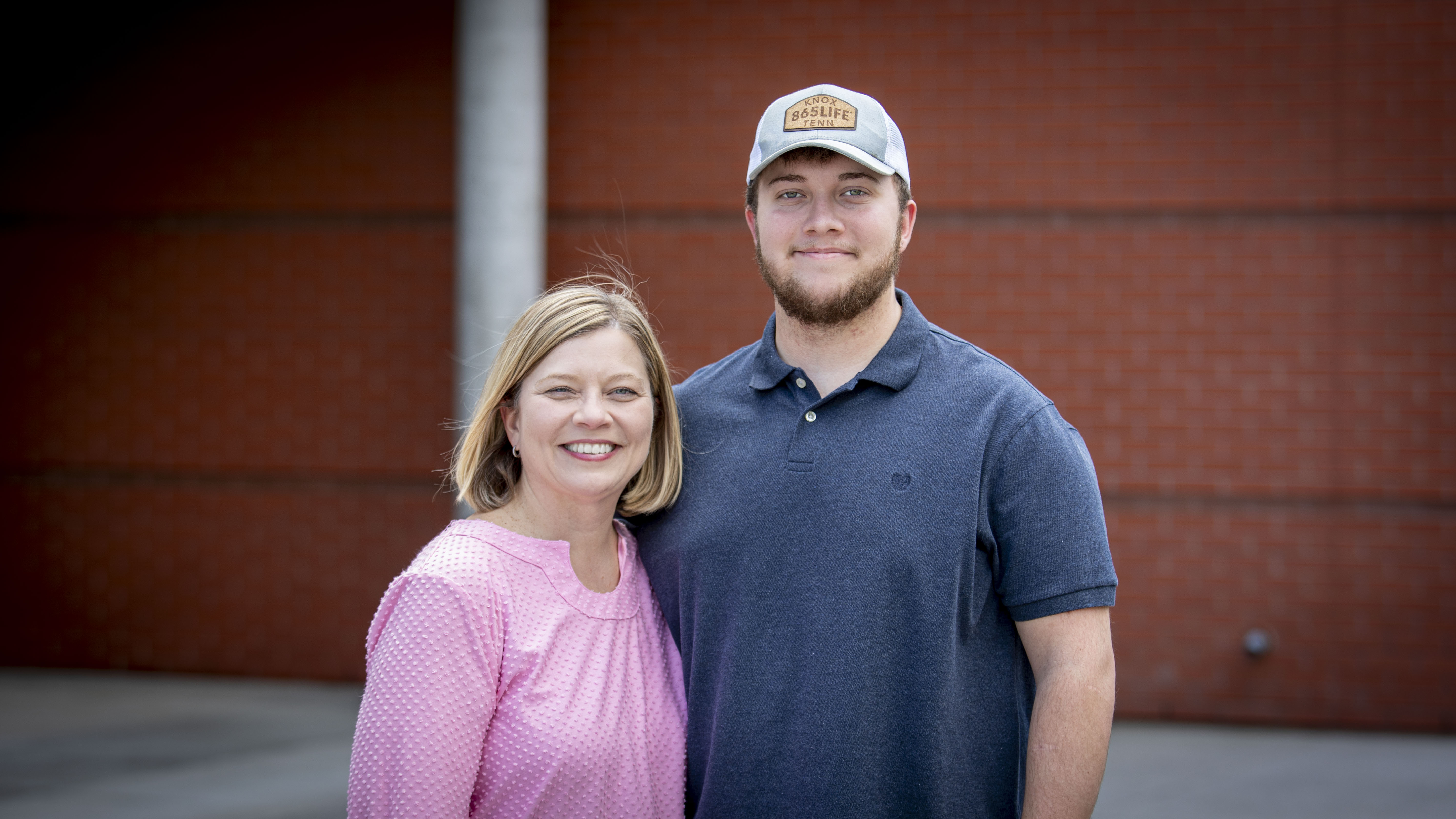
Meet Y-12er mother and son, Patty and Bryson B.
Bryson B., roads and grounds laborer for Y-12 Infrastructure, joined Y-12 in 2021 and thought it was especially neat to see the place his mom and dad worked for many years.
“The best part of working in the same company is being able to spend time with each other more often and occasionally spend time together at work as well,” Bryson said.
Patty B., scheduler in Y-12 Project Controls, who started at Y-12 in 2011, says while their fields of work aren’t related, as a mom, she loves that they have a shared mission at work.
“It’s awesome knowing we both have the opportunity to help our site and our nation in some small way,” she said.
Bryson is grateful for the example his mom has set for him throughout his life.
“My mom has always shown me hard work, respect, and honesty with everything she does, and I try my best to replicate and follow these great examples,” he said.
To say that Patty is proud of her son would be an understatement.
“Bryson has accomplished many things in his life,” she said. “I am thankful and proud of each one, but I am most proud of who he is. He is such a wonderful person. He is a sweet soul, always keeps you laughing, and makes life fun. He is a complete joy to be with, and of course to me, the best son in the world.”
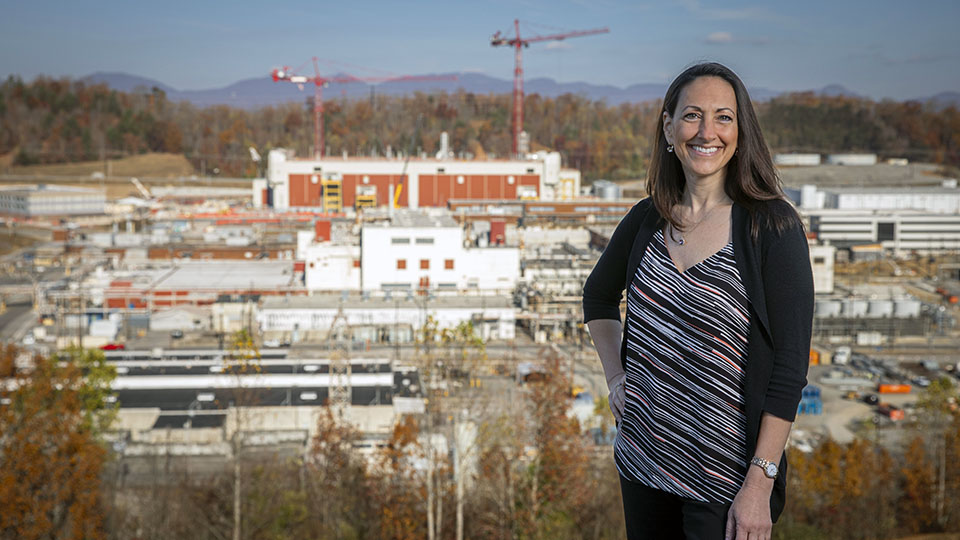
Take 5 minutes to learn about Julie Huff, UPF Commissioning director. All views and opinions are the employee’s own and do not necessarily reflect those of CNS.
Employees of Y‑12 may often feel like they’ve taken a ride in the DeLorean time machine as they travel through the site. Older facilities provide a glimpse into the 1940s and the historic deliveries during the Manhattan Project, while construction of projects such as the Uranium Processing Facility (UPF) and the Lithium Processing Facility (LPF) thrust the landscape into the future.
Julie Huff, UPF Commissioning director, has had the opportunity to work in a number of production facilities across the site throughout her career at Y‑12. Her experiences in older facilities have proven to be an asset in her current role.
“I’ve worked at Y‑12 for almost 23 years now, and I started my role in UPF Commissioning in June 2022. My primary role is to lead the charge to ensure UPF meets all the requirements to operate as a nuclear facility: preparing the people, the paper, and the processes to successfully pass the Operational Readiness Reviews. Preparing the facility to operate also means planning for transition logistics and preparing current Y‑12 operations and personnel for when UPF is construction complete,” Huff said. “I’ve had the good fortune of being able to see and experience the current facilities and work with a wide number of Y‑12 organizations in my years here, and that has helped me tremendously when thinking through the impacts on our Y‑12 employees now and in the future.”
During her tenure at Y‑12, no matter the facility or organization that she has been a part of, Huff has continued to be impressed and inspired by the dedication and perseverance of fellow Y‑12ers and those at Pantex.
“I believe the environment you’ll find at Y‑12 or Pantex, the level of dedication of the people, cannot be beat compared to other places of work,” Huff said. “You feel and appreciate that every job serves an important purpose to our sites as a whole and makes a difference in delivering the mission. This continues to energize me and motivate me every day.”
How has working for CNS changed or reinforced your thoughts on our mission?
I am a nuclear engineer, and I have always been passionate about the capabilities of nuclear energy, but I don’t think I fully grasped the magnitude until I came to work at Y‑12. My grandfather and his brothers served in WW2, and it was when I began working here and seeing the work that we do and the history of the Manhattan Project that really made me fully appreciate what Y‑12 has done for this country. The work done here to help end WW2 did not just impact the world in the 1940s, but continues to this day. The world and war forever changed with our capabilities and with deterrence.
What work advice would you offer someone who is new to Pantex or Y‑12?
My top piece of advice would be that before looking outside the company to grow in your career, explore opportunities within your site in a different organization. I like to say that Y‑12 is its own little city that requires different roles, skills, and knowledge. You can have an amazing career here and work your way up this way.
What’s your top bucket list item and why?
My top bucket list item is to visit Antarctica, and maybe even run in the Antarctica Marathon that is held every year. Yes, there is a marathon in Antarctica. My goal is to visit all seven continents, and Antarctica is the hardest one on my list. It just looks so beautiful, and I hope to see it someday.
Who in your life has inspired you the most and why?
My daughter. She always amazes me and challenges me to be a better person. I love seeing the world through her eyes, and I want to make the world a better place for her now and into the future.
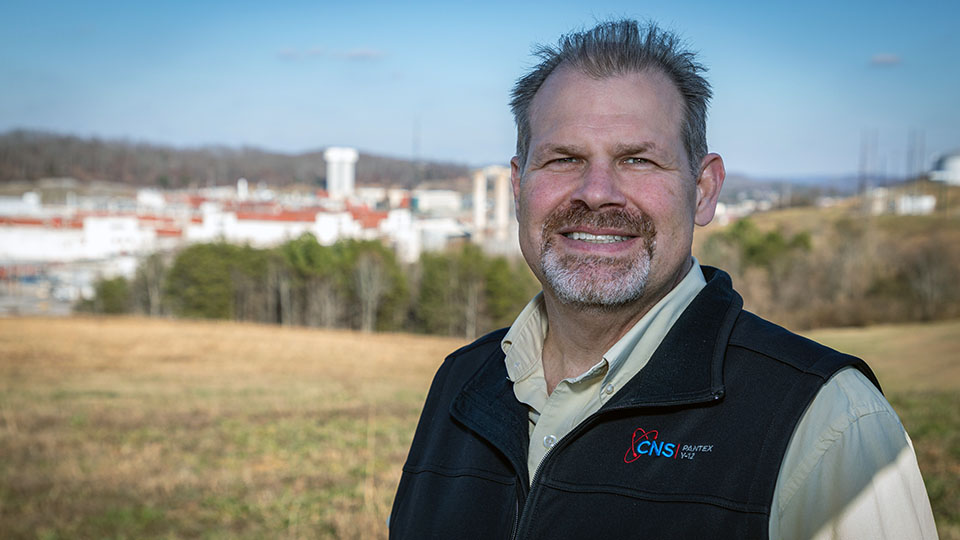
Mike Robinson is in the middle of a climb. It’s a metaphorical climb up a very real mountain of infrastructure modernization work at both Pantex and Y‑12. The work includes the programmatic plans and master site plans at both sites that identify new equipment and infrastructure to be installed and constructed. Robinson, vice president of Project Management, has purview of all the capital projects and many expense projects at both Pantex and Y‑12, excluding the Uranium Processing Facility (UPF). He’s been in his current role for a little over a year now, but as a principal vice president with Bechtel, it’s a continuation of a lifelong career.
“The reality is in 30‑plus years with Bechtel, I’ve moved over a dozen times and covered twice that many different projects or positions; it’s going where the work is needed to address challenges,” Robinson noted.
One challenge that surprised Robinson when he joined CNS was the gravity of the work versus the state of the buildings it’s completed in.
“Our people — not just within Project Management, but across CNS — find ways to be successful in facilities that have overreached their life expectancy,” Robinson said. “In FY 2023, under an increasing workload, CNS not only met but exceeded production goals. Integrated teams across CNS especially demonstrate just how important each person is to overall mission success.”
Project work is increasing to meet both current repair needs as well as to prepare the sites for the future. Buildings like the new fire station and Emergency Operations Center at Y‑12 are clear examples of how new facilities improve not only the work, but also morale. For anyone who works on projects, the on‑the‑job daily problem‑solving has a tangible outcome.
“The passion for the mission extends across the board, throughout the different departments and up and down the ladder, so to speak,” Robinson said.
How has working for CNS changed or reinforced your thoughts on our mission?
Not changed, but reinforced my thoughts on the mission. I appreciated that before, but I’ve gained additional insights into specifics of what projects we are doing to support future mission needs. I also think we’re at a time when the global environment is evolving, and it fully reinforces why our mission is needed or important. We want to play our part by safely and efficiently implementing our infrastructure modernization.
Are you doing what you envisioned as a young adult? If so, describe how you got here.
Absolutely not. I would describe it as a long strange trip. My dad and my uncle were engineers, and my brain seemed wired to build and disassemble things as a kid. I fed that spark by getting a mechanical engineering degree and then headed into the field working construction. I’ve been involved in projects and operating facilities for my entire career. I’ve always gotten satisfaction from completing projects or solving problems, and I have fond memories of the people on the teams we’ve developed along the way.
What work advice would you offer someone who is new to Pantex or Y‑12?
Ask questions. Seek to gain insight from your coworkers about both the work at hand and how it fits into the mission. Getting back to similarities in the sites, it is that general pride in support of the mission that is inspiring. I think that’s unique to these sites because there’s a longer view than just any one project.
Why is it important we hold ourselves accountable in our daily tasks?
strong>
We’re all part of some plan; we all have roles and responsibilities to make it work. By holding ourselves accountable, we’re working to support the mission. If you’re not doing what you’re accountable for, you’re letting someone down. As an example, all projects have challenges — there hasn’t been a project in the history of the world that hasn’t had challenges. Good teams identify and attack issues, so being accountable prepares you to address the challenges of that project. It takes the village to complete our projects, and we need to be accountable so we don’t burden each other.
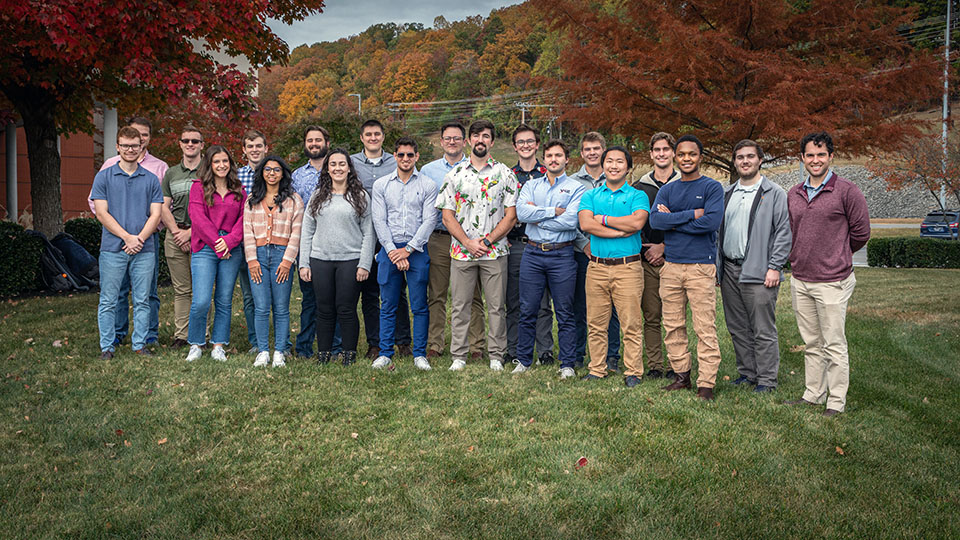
Y‑12 Career ONE Manager Kody C. (far right) with the latest class, which boasts 19 recent engineering graduates.
Consumers may test drive a few cars before they find the right one. At Pantex and Y‑12, Career ONE participants take a similar approach to find the right job.
Debuting in 2011, Career ONE (Opportunities for New Engineers) allows recent college graduates to participate in a job‑rotation program during their first two years at the sites. The newcomers work in different engineering disciplines in 4‑ to 6‑month increments and gain insights into each field so they can better determine which career path is the best fit.
“I found this middle ground between a job and an internship,” said former Y‑12 Career ONE participant Erika R. “It is the perfect program.”
Workshops and training sessions further expand their knowledge and technical skills. In addition, they have access to state‑of‑the‑art equipment and processes. Participants complete up to four rotations, which last a year at Pantex and between a year and 18 months at Y‑12.
“It’s an opportunity to get a broader sense of what’s going on in the company and an opportunity to learn more,” said Pantex Career ONE Manager Steve C. “Helps them hit the ground running.”
Y‑12 Career ONE Manager Kody C. added, “It’s a great program. These engineers are able to gain exposure to our mission and build technical experience. The managers have said how impressed they are with this organization and commented on how enthusiastic Career ONE classes have been.”
Participants, many introduced to Career ONE at job fairs, hail from schools such as the University of Tennessee, Tennessee Tech University, Georgia Institute of Technology, and Texas Tech University.
The past two classes are part of a growth spurt for Y‑12 Career ONE. The FY 2021 and 2022 groups boasted 14 and 15 members, respectively. The FY 2023 class had 19. At Pantex, the classes are smaller, with usually eight engineers entering the program each year. The program is in its fifth year there.
“We have plans to grow it,” Steve said. “In the next four to five years, would we would like to see it increase to about 15 people.”
As established groups finish their rotations, new grads come onboard, fostering a mentoring environment.
“Former Career ONE participants are the coaches for the current Career ONE class,” Kody said. “They help them get connected from a networking perspective.”
Although creating those connections is key to success at the sites, the opportunity to work in various areas of engineering is invaluable.
“For this generation that comes out of college, it’s all about choices,” Steve said. “They thrive on that.”
Among this generation is Claire F., who recently completed her final rotation at Y‑12.
“This is my first job out of college,” she said. “Career ONE helped me to see my strengths and weaknesses and to see what parts of engineering I enjoy. I was worried coming into a new job and not liking it, but with this, I got a chance to try a few jobs. I really like my current position in Process Engineering, but I also enjoyed my time in Design. It’s been great to see all of the different sides. It gave me some really good options.”
The options also allow an easier entry into a new and sometimes daunting job world.
“Going in blind (to a single job) would have been intimidating,” said former Y‑12 Career ONE participant Adam .., who was deployed to Process Engineering. “This way, I got a chance to see what I liked and didn’t like.”
Also recently deployed to Y‑12 Process Engineering is Michael H.
“This program has been fantastic,” he said. “It was perfect for my personality type. I’m always thinking, would I be better somewhere else or would I be happier somewhere else? Thankfully, I enjoy this job so much. It’s like a birds‑eye view of what’s going on here, like being backstage, which is perfect, because I’m always craving knowledge.”
For former Pantex Career ONE participant Austin F., “I came in not knowing what exactly I wanted to do. All I knew is that I wanted to be an electrical engineer. CareerOne allowed me the ability to shift around and choose a group that was the best for me. He works in the Projects Electrical Design group at Pantex.
There’s a good chance Austin and other Career ONE employees will remain at Pantex and Y‑12 for years to come, which is good news. Both sites have been focused on attrition rates.
“Because of the positive experience they have in the program, they tend to stay at Y‑12 for a while,” Kody said. “We set them up for success with all the access to the site.”
Steve has seen strong retention at Pantex as well, with Career ONE graduates on average working at the site for several years after program completion.
“It takes a few years to get acclimated and to contribute fully,” Adam said. “I could easily see myself being here five‑plus years.”
Austin said, “The chances of me staying at Pantex are high, I would say, as long as I’m putting out quality work. I’m in a good group and I love the people here.”
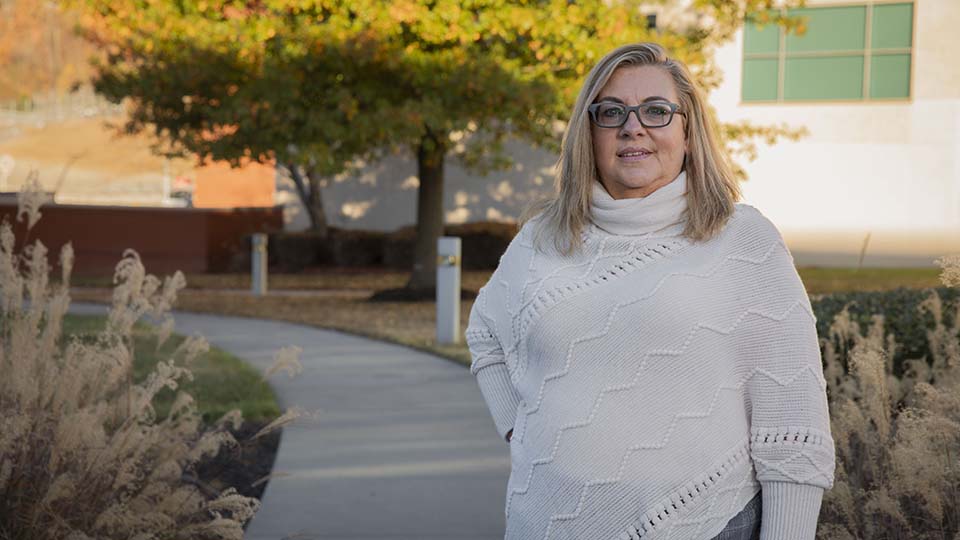
Marcia B. has been working for the federal government or as a contractor since she was 16. “I worked as a student aide at the [Oak Ridge] Federal Building,” she said. From there, she had various Department of Energy assignments in Oak Ridge, including scanning records, transcribing personnel security interviews, and a stint in Waste Management.
After managing a group of support staff in Waste Management, she began working for Safeguards and Security. “My love for safeguards and security started then,” she recalled. “What we call an enterprise assessment now was handled locally then. I enjoyed going out on audits. I remember thinking, ‘Why can’t you implement these requirements?’ Once I came to Y‑12, I realized the requirements are not that easy to implement.”
Marcia said, “The hardest thing about implementation is making sure everyone understands the requirements. You have to make the policy clear and concise and implement consistently and constantly.”
She says the best part of her job is finding a solution to a potentially negative situation. “For example,” she explained, “when our shipments were shut down, brainstorming on storage options and meeting with people for resolution was rewarding. You can see that you’ve made a difference … a positive impact on the site.”
“I can’t imagine doing anything else,” she said. “I always wanted to do something with the government where I could make a difference in the country and have a positive effect on us as a nation.”
Are you doing what you envisioned as a young adult? If so, describe how you got here.
Yes and no. I grew up around this area, so working at one of the government sites was always on my radar. As a young girl, I had always heard they make good money. Growing up with a single mom who couldn’t afford much, ‘good money’ sounded great. However, when I started college, my goal was to become a corporate lawyer … that’s too long of a story to tell … let’s just say that several years later I ended up receiving a degree in criminal justice, and that was much more interesting.
What is your favorite aspect about your work environment? How does that aspect make you know the mission is being met?
The people. We have some really fascinating people who work here, and I am so thankful every day that I have been blessed to get to know them. It takes all of us to meet the mission just like it takes a village to raise a child. While I have a part to play, it’s all the tiny parts that each of us play that ensure we are able to meet the mission and support the greatest country on earth.
What work advice would you offer someone who is new to Pantex or Y‑12?
Learn all you can and don’t be afraid to ditch what you know and try something new. Our sites are so diverse and there are so many jobs that you can chose to do out here. If you’ve mastered one, don’t be afraid to jump into another one.
What one thing would your coworkers be surprised to know about you?
Those close to me know I have held a clearance since I was 16 years old. The other secret is that I really like to sing, but I am afraid to do so in public.
What is the top lesson you have learned by applying problem‑solving skills to an issue? What advice would you offer a newer employee about the importance of solving problems and asking questions?
In my mind these questions go hand in hand.
As a new employee, we spend a lot of time in class and on the floor learning various aspects about the site and, more importantly, about our job and its role in the site’s mission. All of that information is important to our success, but our ability to ask questions and begin to put our problem‑solving skills to the test is more important. New employees bring both their skills and a fresh set of eyes. What they see and how we operate may not make sense. Ask questions to learn and offer possible solutions. You’ll become more knowledgeable and our site will improve.
I am a problem solver at heart. I love puzzles and riddles, and I also ask questions a lot. I am happiest when I am able to find a solution to a complex problem, whether that’s for the site or my family. The most important lesson I’ve learned about being a good problem solver is that there is almost always more than one way to solve a problem. Working with others, brainstorming, and doing research to understand history go a long way toward ensuring you are able to provide a solution that is logical, cost effective, and agreeable to most, if not all, stakeholders.
